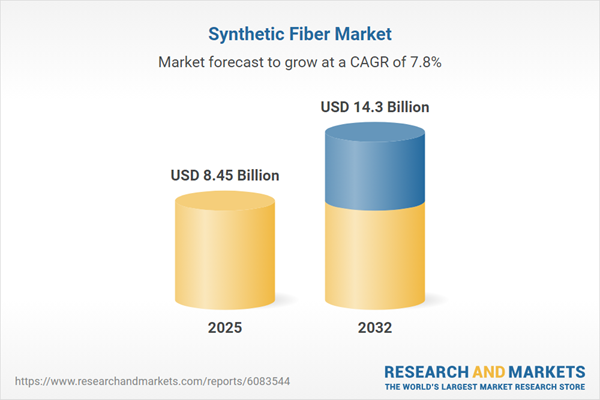Speak directly to the analyst to clarify any post sales queries you may have.
The synthetic fiber market is undergoing a significant transformation, as industry advancements, sustainability mandates, and global trade developments accelerate innovation and redefine competitive priorities for manufacturers, suppliers, and end-users. Senior leaders navigating this evolving sector require actionable insights that address technological, regulatory, and commercial shifts shaping future opportunities.
Market Snapshot: Synthetic Fiber Market Size, Growth, and Forecast
The Synthetic Fiber Market grew from USD 7.82 billion in 2024 to USD 8.45 billion in 2025. It is expected to continue growing at a CAGR of 7.83%, reaching USD 14.30 billion by 2032.
Scope & Segmentation: Detailed Market Breakdown
- Fiber Types: Covers acrylic, nylon (Nylon 6, Nylon 6.10, Nylon 6.6), polyester (PBT, PET, PTT), polypropylene (copolymer, homopolymer), and spandex.
- Manufacturing Processes: Includes dry spinning, melt spinning, and wet spinning, each supporting specific fiber engineering requirements.
- Applications: Spans apparel (children’s, men’s, women’s wear), automotive (interior, under-the-hood), home furnishing (bedding, carpet, upholstery), industrial (filtration, geotextiles, rope & cordage), and medical (medical gauze, surgical clothing).
- Regional Coverage: Details the Americas (United States, Canada, Mexico, Brazil, Argentina, Chile, Colombia, Peru), Europe, Middle East & Africa (major markets across UK, Germany, France, Russia, Italy, Spain, Netherlands, Sweden, Poland, Switzerland, United Arab Emirates, Saudi Arabia, Qatar, Turkey, Israel, South Africa, Nigeria, Egypt, Kenya), and Asia-Pacific (China, India, Japan, Australia, South Korea, Indonesia, Thailand, Malaysia, Singapore, Taiwan).
- Leading Companies Profiled: Analysis of Indorama Ventures Public Company Limited, Toray Industries Inc., Reliance Industries Limited, Sinopec Yizheng Chemical Fibre Co., Ltd., Teijin Limited, DuPont de Nemours Inc., Hyosung Corporation, Far Eastern New Century Corporation, Lenzing AG, Invista, LLC.
Key Takeaways for Senior Decision-Makers
- Material innovation and process optimization are extending synthetic fibers' reach into advanced sectors like medical, automotive, and high-performance textiles.
- Shifts in consumer preferences and stricter environmental standards are prompting industry-wide investment in bio-based inputs, closed-loop recycling, and reduced-emission manufacturing technologies.
- Strategic alliances, including joint ventures and collaboration between fiber producers, brands, and recyclers, are strengthening supply chain resilience and opening new commercialization channels.
- Digital transformation across manufacturing and quality control processes is improving operational efficiency and enabling predictive monitoring, with digital twin technology and real-time analytics rapidly gaining traction.
- Emerging regional clusters, particularly in Asia-Pacific, are becoming pivotal for specialty production and supply diversification, impacting cross-border trade and innovation ecosystems.
- Competitive dynamics are intensifying as incumbents and agile entrants leverage R&D and sustainability initiatives to differentiate in a crowded marketplace.
Tariff Impact: U.S. Import Duties and Global Realignment
Newly imposed U.S. import duties on select synthetic fiber categories are causing manufacturers to reevaluate sourcing strategies and production locations. These tariffs have led to increased regional production, stimulated capacity investments in North America, and encouraged alternative procurement from non-affected Asia-Pacific suppliers. This is resulting in more secure supply chains and innovation in premium fiber offerings as businesses adjust to changing cost structures and seek to maintain market share.
Methodology & Data Sources
This report utilizes a rigorous methodology, integrating primary interviews with industry executives, R&D leaders, and senior operations personnel, alongside extensive secondary research from corporate filings, peer-reviewed journals, and industry association sources. Triangulation ensures the accuracy of technological, environmental, and economic insights.
Why This Report Matters to Industry Leaders
- Supports strategic decisions around investment, product development, and supply chain optimization in a complex global market.
- Delivers an in-depth understanding of regulatory shifts, sustainability requirements, and regional expansion opportunities.
- Enables benchmarking against leading players’ innovation strategies, digital transformations, and collaborative initiatives.
Conclusion
Senior stakeholders can leverage these findings to align strategic planning with sector-wide innovation, regulatory transformation, and evolving consumer dynamics. This report empowers decision-makers to drive sustainable growth, build resilient operations, and maintain a competitive advantage as the synthetic fiber landscape continues to advance.
Table of Contents
3. Executive Summary
4. Market Overview
7. Cumulative Impact of Artificial Intelligence 2025
List of Figures
Samples

LOADING...
Companies Mentioned
The key companies profiled in this Synthetic Fiber market report include:- Indorama Ventures Public Company Limited
- Toray Industries, Inc.
- Reliance Industries Limited
- Sinopec Yizheng Chemical Fibre Co., Ltd.
- Teijin Limited
- DuPont de Nemours, Inc.
- Hyosung Corporation
- Far Eastern New Century Corporation
- Lenzing AG
- Invista, LLC
Table Information
| Report Attribute | Details |
|---|---|
| No. of Pages | 194 |
| Published | October 2025 |
| Forecast Period | 2025 - 2032 |
| Estimated Market Value ( USD | $ 8.45 Billion |
| Forecasted Market Value ( USD | $ 14.3 Billion |
| Compound Annual Growth Rate | 7.8% |
| Regions Covered | Global |
| No. of Companies Mentioned | 11 |









